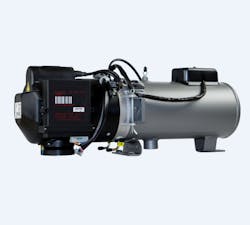While coolant heaters have traditionally been used to preheat engines in cold temperatures as a means of reducing wear, trimming idle time and improving fuel efficiency, a growing number of fleets are realizing they can also improve the performance of diesel particulate filters (DPFs) in any climate.
By drawing cold coolant into a heat exchanger where it is warmed to about 165 degrees and then returned to engine, coolant heaters cut emissions at start-up, reducing the amount of particulate matter (PM) the DPF has to capture and burn. The heaters also shorten the time it takes for exhaust gases to reach regeneration temperatures.
“In our testing, we’ve found that by preheating an engine you reduce the amount of PM entering the aftertreatment system by over 60% and reduce NOx by 40%,” said Duane Bratvold, western U.S. business development manager for Webasto Thermo & Comfort North America. “By minimizing the wet, dense soot and PM emissions associated with cold engine starts, pre-heating reduces filter overloading and face plugging, and significantly increases the time between DPF regenerations and cleanings. This is particularly important on shorter routes where the vehicle is not driven long enough for exhaust temperatures to reach the high-temperature need for regeneration.”
Along with that reduction in downtime for DPF service and associated maintenance costs savings, Bratvold points out that the return on investment from a coolant heater can be realized from several factors.
“There are fuel savings due to reduced idling time and less wear and tear on the engine without cold starts,” Bratvold said.
He added by pre-heating the “engine the oil is warmer, sealing piston rings and diminishing blow-by. DPF tanks and injectors are also protected from freezing, increasing their overall efficiency and reliability. And because the engine and coolant will be already warm you will have immediate heat in the cab through the vehicle’s HVAC system.”
Bratvold explained the average cost to clean a DPF properly during routine preventive maintenance can range for $350 to $500.
However, “the average cost to replace a DPF is anywhere from $2,500 to $5,000, plus downtime. In addition, coolant heaters require minimal maintenance, only an annual fuel filter replacement if equipped and simple checks of electrical, fuel and coolant connection points,” Bratvold said.
Coolant heaters on the market include Webasto’s Thermo Top C, which is approved by the Environmental Protection Agency and California Air Resources Board. The Thermo Pro 90 model features altitude adjustment and Arctic Start for vehicles operating in extremely cold conditions.
The company also offers the Webasto DBW 2010 that provides engine pre-heating and interior heat in one unit, and can be used with additional accessories to warm the fuel and prevent gelling. The manufacturer also offers its SmarTemp Control fx 2.0 system, which enables programmable run times and features a cab temperature selector dial, push-button controls and a backlit LED screen.
Elsewhere, Eberspaecher Climate Control System’s Hydronic D5 coolant heater features automatic heat regulation at multiple levels and built-in self-diagnostics. Also available are digital timers or key fob controls. In addition, Arctic Fox offers standard and custom coolant heaters in a variety of configurations.
The savings that can result from using engine coolant heaters, including reduced DPF maintenance costs, extended regeneration cycles, less filter overloading, face plugging and thermal cracking, fuel cost savings and eliminating cold starts, are all reasons to consider using them on trucks in both warm and cold climates.
About the Author
Fleet Owner Staff
Our Editorial Team
Kevin Jones, Editorial Director, Commercial Vehicle Group
Cristina Commendatore, Executive Editor
Scott Achelpohl, Managing Editor
Josh Fisher, Senior Editor
Catharine Conway, Digital Editor
Eric Van Egeren, Art Director
